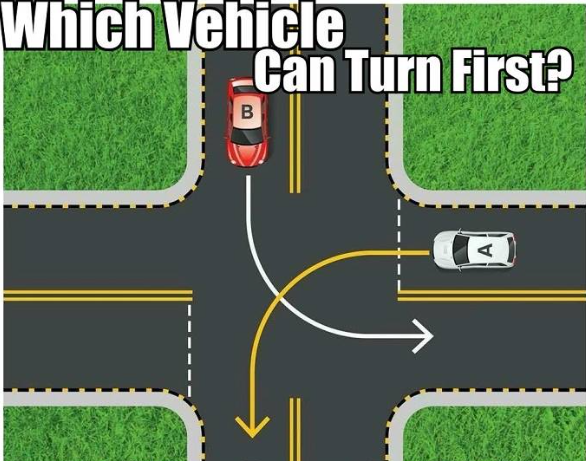Navigating intersections can be tricky, especially when there are no traffic signs or signals to guide you. In today’s scenario, two cars—Car A and Car B—are positioned to make turns, with no visible traffic signs or lights to indicate who should go first. Car A, a white vehicle, plans to make a right turn, while Car B, a red vehicle, is preparing for a left turn. So, how do we determine which car has the right of way? Let’s break down the rules and solve this common driving dilemma.
Understanding the Situation: Car A vs. Car B

At first glance, you might think both cars can simply proceed with their turns. But as with many intersection puzzles, a closer look reveals important details. Let’s examine the factors in play here.
Car A, preparing to make a right turn, is positioned behind the dotted lines, while Car B intends to make a left turn across an open lane. Given this setup, we need to consider a few essential factors to determine the right of way accurately.
Key Factors to Consider in Right-of-Way Scenarios
When approaching intersections without stop signs or traffic lights, understanding right-of-way rules becomes essential. Here, we’ll focus on three major elements that help decide who should go first.
Dotted Lines and Lane Markings
The presence of dotted lines on the road serves as a critical indicator in this scenario. Dotted lines usually signify a boundary or a point at which one vehicle should yield to another. In this case, Car A’s position behind the dotted lines suggests it should wait, giving way to Car B.
Direction and Complexity of the Turn
Car B is making a left turn, which is typically more complex than a right turn. Left turns often require crossing an extra lane of traffic, making them inherently riskier. For this reason, vehicles making right turns, like Car A, generally yield to those making left turns when they are positioned behind a boundary like the dotted lines.
Avoiding Simultaneous Turns
It might seem that both cars could turn at the same time, but this would increase the risk of a collision. Because Car B needs to make a broader turn that crosses multiple lanes, it’s safer to let Car B proceed first. Attempting simultaneous turns at intersections without clear guidance can lead to accidents, so the general rule is to yield when in doubt.
Who Has the Right of Way? The Answer
Based on the analysis of road markings, turn direction, and vehicle positioning, Car B (the red vehicle) has the right of way in this situation. Car A, positioned behind the dotted lines, should yield until Car B has completed its left turn. This approach ensures a safer, more controlled flow of traffic.
Why Car B Proceeds First
Position Relative to Dotted Lines
Car A’s position behind the dotted lines signals that it must give way to Car B. These dotted lines act as a visual guide, directing Car A to wait for Car B’s broader, leftward turn to finish.
Collision Risk Reduction
Simultaneous turning by both vehicles would put them on a collision course, given Car B’s wider turn trajectory. Allowing Car B to go first reduces the chance of their paths crossing unsafely.
Traffic Rules for Complex Maneuvers
Traffic guidelines often give priority to the vehicle executing the broader, more complex turn—such as a left turn that crosses lanes—over the simpler right turn. This reduces the likelihood of misunderstandings and minimizes potential traffic conflicts.
What Should Car A Do in This Situation?
If you’re in Car A’s position, the best action is to stay put and wait until Car B completes its turn. Exercising a little patience can prevent unnecessary accidents and keeps traffic moving smoothly. Even though Car A’s right turn may seem simpler and quicker, yielding to Car B is the safest choice here.
When There Are No Traffic Signs, Follow Common-Sense Rules
Intersections without traffic signs or signals demand extra attention and judgment. While it may seem chaotic, adhering to a few straightforward rules can help you make the safest decision.
- Yield to the Vehicle Making the Broader Turn: Vehicles making left turns generally have a more complicated path, so it’s best to allow them to proceed first.
- Pay Attention to Road Markings: Dotted lines and other lane indicators offer valuable guidance for determining right of way. Positioning behind dotted lines suggests yielding to other vehicles.
- Prioritize Safety Over Speed: Rushing through intersections without proper guidance can lead to collisions. Remember, taking a few extra seconds to assess the situation is well worth it.
Final Answer: Car B Has the Right of Way

In conclusion, Car B, the red vehicle preparing to make a left turn, has the right of way in this intersection scenario. Car A, positioned behind the dotted lines, should yield until Car B has safely completed its turn. This approach reduces the risk of collision and follows common right-of-way practices.
Did You Get It Right?
This puzzle challenges our understanding of right-of-way rules and the importance of paying close attention to road markings and turn complexity. If you found the answer, great job! You’ve demonstrated a keen understanding of intersection etiquette. And if you didn’t, don’t worry—puzzles like these are a fantastic way to sharpen your driving skills and prepare for real-world scenarios.
Remember: Safe Driving is Smart Driving
Knowing who has the right of way isn’t just a technical skill; it’s a crucial part of driving safely. By practicing patience, understanding traffic guidelines, and making safe decisions, you contribute to a smoother, safer experience for everyone on the road.


